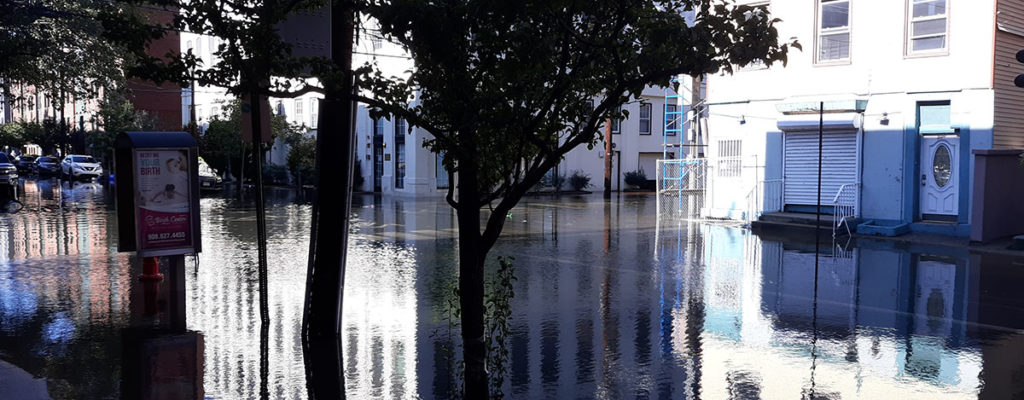The torrential rains from Ida cause the worst flooding since Superstorm Sandy nine years ago

The morning after Ida, a flooded intersection at Third Street and Clinton in Hoboken.
Are you in the new flood zone? Use the FEMA address lookup tool for Region II to find out: Address Lookup
FBW | September 14, 2021
Since Superstorm Sandy hit the region nine years ago, Hoboken, aided with a $230 million federal grant, has made a concerted effort to implement a series of flood mitigation measures. New parks on the western side of town include stormwater detention systems. Rain gardens and bioswales have been constructed throughout town. Three wet weather pumping stations, costing tens of millions, have been built since 2010. Yet what has been completed to date was overwhelmed by Ida, which put parts of town under several feet of water, flooding basements and causing untold damage.
Hurricane Ida hit the Louisiana coast with devastating force. But the greatest number of deaths occurred in New York and New Jersey where a half foot of rain water in just a few hours caused the worst flooding since Sandy. Twenty-five people drowned in New Jersey, many stranded in their cars. Thirteen died in New York, 11 of whom were trapped in their flooded basement apartments.
Hoboken was spared any fatalities but many streets and intersections at low-lying areas at the southern and western portions of the city were impassable, even the morning after. Flooding in Hoboken has been occurring with increased frequency due to more storms of greater intensity. Just a week earlier Henri also caused major flooding. Hoboken, as well as New York City and many other municipalities, has a combined sewer system that collects rainwater, untreated human waste and industrial waste into one pipe. As a result, floodwaters contain harmful bacteria and chemicals thus posing a serious health hazard.
Hoboken was just one of ten sites impacted by Sandy to be selected for the federal River Rebuild by Design program. The Dutch design firm OMA assembled a team of engineers, planners and experts that came up with a comprehensive flood mitigation plan dubbed Resist Delay Store Discharge.
Most of the $230 million Rebuild by Design grant, now managed by the New Jersey Department of Environmental Protection, is dedicated to building the Resist segment. This consists of a flood wall to protect against future storm surges similar to Superstorm Sandy. During Sandy, the surge pushed waters from the Atlantic Ocean into the New York Harbor flooding coastal communities throughout the metropolitan area. Sandy breached the coastline at the south and north ends of Hoboken filling the low-lying areas all the way west to the base of the Palisades cliffs.
Construction of Hoboken’s floodwall began just a few months ago after nine years of planning and public meetings led by teams of engineers and other experts. Completion of the Resist segment is expected in the fall of 2022. The flood wall which extends into portions of Jersey City to the south and Weehawken to the north would have no impact on flash flooding caused by major rain storms, only on another surge, considered a relatively rare event.
The Delay, Store, Discharge portion of the project has fallen upon the City of Hoboken in partnership with the North Hudson Sewerage Authority (NHSA) as funding becomes available. The City has completed two major water retention sites and a third is under construction. Southwest Park, built in 2017, has the capacity to store up to 200,000 gallons of stormwater. A park at Seventh and Jackson Streets has a 466,000 gallon capacity. Northwest Park, currently under construction, will store 1 million gallons.
The City has also created a series of rain gardens and bioswales along Washington Street, Clinton and First Streets to absorb more stormwater. Similar green infrastructure is planned in the Northwest Park area. Since 2010, the NHSA has installed three new wet weather pumping stations in Hoboken in an effort to further ameliorate stormwater flooding.
The serious flooding that occurred during Ida and other storms raises questions about the effectiveness of Hoboken’s flood mitigation efforts. Is the $230 million federal grant focused on the most effective solutions? Do the stormwater detention facilities have sufficient capacity to handle major rainfall events? Should Hoboken be separating stormwater from wastewater lines in the areas that flood the most?
After Sandy, Hoboken adopted amended flood ordinances that required new buildings to raise residential units above what is called the Design Flood Elevation. The areas below can contain parking garages and retail space but must be flood proofed so that flood waters entering the lower levels of these structures will be able to withstand the assault of water with minimal impact. This offers new buildings the capacity to recover from storms with minor damage. Yet most of Hoboken’s buildings are vulnerable, having been built more than a century ago or prior to the adoption of this ordinance.
Only time will tell if the Rebuild by Design strategies for Hoboken will ultimately succeed or need to be rethought. Of course, at this point, the investment of the $230 million in the flood wall to protect against another surge is an irreversible decision. Whether that surge will occur next year or in 100 years, again only time will tell.
Related Webpages
Flood Hazard Assessment for New York Harbor
City of Hoboken Flood Mitigation
Related Links
Rebuild by Design floodwalls would have had no impact on Friday’s flash flooding
New York City’s flood hazard maps found to be inaccurate; so what about Hoboken?
Sea level rise will put half of Hoboken underwater by the next century
Are Hoboken’s proposed floodwalls based on overstated risk of another Superstorm Sandy?
What are the best strategies for making Hoboken flood-resilient?
Walling off Hoboken’s waterfront meets fierce resistance
Dutch-led team: Resist, Delay, Store, Discharge: a comprehensive strategy for Hoboken
Are we devising flood remedies based on a 1,000 year storm?
79% of Hoboken falls into FEMA’s new flood zone!

